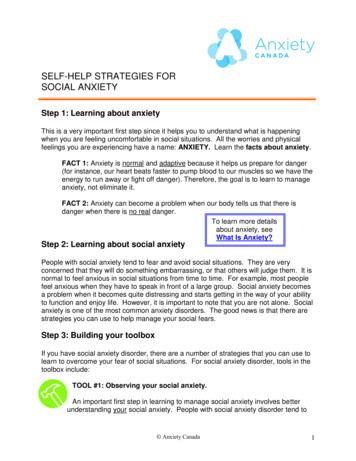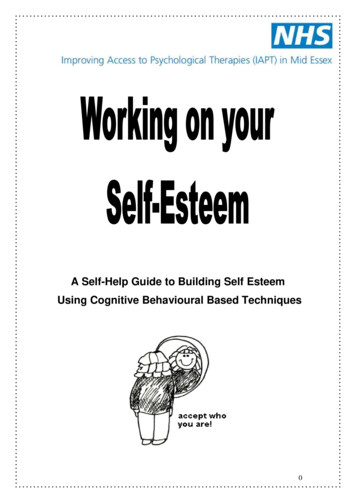
Transcription
SELF-HELP STRATEGIES FORSOCIAL ANXIETYStep 1: Learning about anxietyThis is a very important first step since it helps you to understand what is happeningwhen you are feeling uncomfortable in social situations. All the worries and physicalfeelings you are experiencing have a name: ANXIETY. Learn the facts about anxiety.FACT 1: Anxiety is normal and adaptive because it helps us prepare for danger(for instance, our heart beats faster to pump blood to our muscles so we have theenergy to run away or fight off danger). Therefore, the goal is to learn to manageanxiety, not eliminate it.FACT 2: Anxiety can become a problem when our body tells us that there isdanger when there is no real danger.To learn more detailsabout anxiety, seeWhat Is Anxiety?Step 2: Learning about social anxietyPeople with social anxiety tend to fear and avoid social situations. They are veryconcerned that they will do something embarrassing, or that others will judge them. It isnormal to feel anxious in social situations from time to time. For example, most peoplefeel anxious when they have to speak in front of a large group. Social anxiety becomesa problem when it becomes quite distressing and starts getting in the way of your abilityto function and enjoy life. However, it is important to note that you are not alone. Socialanxiety is one of the most common anxiety disorders. The good news is that there arestrategies you can use to help manage your social fears.Step 3: Building your toolboxIf you have social anxiety disorder, there are a number of strategies that you can use tolearn to overcome your fear of social situations. For social anxiety disorder, tools in thetoolbox include:TOOL #1: Observing your social anxiety.An important first step in learning to manage social anxiety involves betterunderstanding your social anxiety. People with social anxiety disorder tend to Anxiety Canada1
fear different types of social situations (e.g., talking to co-workers, speaking in ameeting, going to parties, etc.) and experience different physical symptoms of anxiety(e.g., blushing, sweating, increased heart rate, etc.). Get to know your social anxiety.Take a couple of weeks to notice which situations cause you anxiety and what youexperience physically when you are in those situations. It can help to write these thingsdown. It is a lot easier to manage your anxiety when you have a better understanding ofit!TIP: In order to help you better observe your social anxiety, make a chartwith three columns - date, situation, and anxiety symptoms. Use this chartto help you track the social situations that cause you anxiety and what youexperience in those situations.For example:Date:January 12thSituation:Talking to cashier at grocery storyAnxiety Symptoms:rapid heart rate,dizziness, dry mouth,upset stomachTOOL #2: Learning to relax.Feeling anxious can be very uncomfortable. By learning to relax, you can “turndown the volume” on the physical symptoms of anxiety, which can make it a little easierto face social situations. Two strategies that can be particularly helpful are:1. Calm Breathing: This is a strategy that you can use to calm down quickly. We tendto breathe faster when we are anxious. This can make us feel dizzy and lightheaded,which can make us even more anxious. Calm breathing involves taking slow, regularbreaths through your nose. However, it is important to realize that the goal of calmbreathing is not to eliminate anxiety completely (because anxiety is not dangerous andit’s normal to feel anxious at times), but to make it a little easier to “ride out” the feelingsin social situations.For more information see How to do Calm Breathing.2. Muscle Relaxation: Another helpful strategy involves learning to relax your body.This involves tensing various muscles and then relaxing them. This strategy can helplower overall tension and stress levels, which can contribute to anxiety problems.For more information, see How To Do Progressive Muscle Relaxation. Anxiety Canada2
TOOL #3: Realistic thinkingPeople with social anxiety disorder tend to have negative thoughts aboutthemselves and about what will happen in social situations.Common examples include:“No one will like me!”“I’m going to say something stupid.”“I’ll do something foolish and other people will laugh!”“I won’t know what to say.”“I’m not as smart/attractive as other people.”“No one will talk to me.”“I’ll get anxious and others will notice.”“Others will think I’m boring.”“I’ll make a mistake and others will think I’m stupid.”If you believe that social situations are threatening or dangerous, then you are morelikely to feel anxious. However, it is important to realize that your thoughts are guessesabout what will happen, not actual facts. People with social anxiety disorder tend toover-estimate the degree of danger in social situations. Therefore, developing morerealistic ways of thinking is an important step in managing your anxiety. But before youcan start changing the way you think, you need to be able to identify the kinds ofthoughts you have in social situations.How To Do ItFirst, ask yourself what you are afraid will happen in social situations; you mightbe afraid of something that you might do (e.g., “I’ll embarrass myself by sayingsomething stupid,” “I’ll have nothing to say,” “I’ll blush,” etc.) or something thatother people might think (e.g., “Others won’t like me,” “Others will notice I’manxious and think I’m weird,” etc.). To become more aware of your specific fears,try and identify your thoughts (and write them down) whenever you feel anxiousor feel an urge to avoid or escape a situation. If it’s difficult to write down yourthoughts while you’re in the situation (e.g., while giving a presentation at ameeting), then try and write them down just before you enter the situation, orimmediately after you leave. Repeat this exercise for a week or so. Anxiety Canada3
The next step involves learning to evaluate your negative thoughts. Remember,your thoughts are guesses about what will happen, not actual facts. It can behelpful to ask yourself whether your thoughts are based on facts and whetherthey are helpful. If they aren’t, try and identify more accurate and helpfulthoughts.Here are some questions to help you examine your thoughts:Am I 100% sure that will happen?How many times has actually happened?What is the evidence that supports my thought? What is the evidence that doesnot support my thought?Is really SO important that my whole future depends on it?Does ’s opinion reflect everyone else’s?Am I responsible for the entire conversation?What is the worst that could happen?What can I do to cope/handle this situation?Do I have to please everyone – is that even possible?What is another way of looking at this situation?What would I say to my best friend if he/she was having this thought?Example:What am I afraid will happen if I go to the party? I’ll say something stupid.Am I 100% certain that I’ll say something stupid at the party? No, not 100% certain.How many times have I said something stupid at a party? A few times, but notevery time.What is the evidence that supports my thoughts? Once, I made a joke that no onelaughed at. Another time, I made a comment about a movie that didn’t make sense.And another time, I asked an obvious question and someone started laughing.What is the evidence that does not support my thoughts? I have gone to parties inthe past and did not say anything stupid. I have had a few good conversations atparties. The last time I went to a party, someone said I was funny.(continued) Anxiety Canada4
Is not saying something stupid so important my whole future depends on it? Well,it would be embarrassing, but no, my whole future does not depend on it.What is the worst that could happen? I do say something stupid and people laugh.What could I do to cope? I guess I could try and crack a joke about it. Or, I couldexcuse myself and go get some fresh air.Is there another way of looking at this situation? Everyone says stupid things oncein a while.What would I say to a friend who had this thought? It’s not the end of the world. Weall say silly things and most of the time people don’t remember exactly what you said.For more information on identifying and evaluating scary thoughts, see RealisticThinking.TIP: People with social anxiety disorder often hold some unrealisticbeliefs. Common examples include:I need to be perfect to be likedI should never make mistakesIt is important for everyone to like meIt’s not okay to be anxiousHowever, no one is perfect and everyone makes mistakes. Also, it’s unrealisticto think everyone will like us - Do you like everyone? Anxiety is often a privateexperience that others don’t notice. Even if they do, it doesn’t mean that theywill think less of you – Haven’t you ever seen someone else anxious? It’snormal. It’s okay to be imperfect and to feel anxious. It’s part of being human!Rather than fighting these things, try working on accepting them.By evaluating your negative thinking, you may realize that some of the things you fearare very unlikely to actually happen, or that if something does happen it’s not as bad asyou may think and that you can cope. Practise evaluating your anxious thoughts by firstwriting them down and then trying to identify more realistic ways of thinking (by using thequestions presented in this section, as well as those presented in the RealisticThinking module). Anxiety Canada5
Test it out!Sometimes it can be helpful to examine the truthfulness of your thoughts or beliefs. Forexample, how bad would it be if others saw you blush/shake, or how terrible would it beif you said something foolish? We often assume that it would be horrible if these thingshappened, and that we would be unable to cope. However, we need to test this out!Purposely try to shake, and see how others react. Plan to say something foolish or askan obvious question and see what happens! Be careful not to assume that others arereacting negatively – look at the facts! What did they do or say? Was it as bad as youthought?Examples of experiments include: Ask a “silly” question (e.g., ask for directions to a street you are already on) Let your hand shake while holding a glass of water Spill a drink Drop something or knock something over Wear your shirt inside out Send an e-mail with spelling mistakes Mispronounce a word Pretend to lose your train of thought and stop mid-sentence Pretend to trip Wait for the cashier to close the till and then ask for changeTOOL #4: Facing fearsIt’s normal to want to avoid situations that cause you anxiety. Avoidingfeared social situations is a very effective strategy because it reduces anxiety in theshort-term. However, avoiding social situations increases your fear in the long-termbecause it prevents you from learning that your feared expectations are either unlikely toactually happen or aren’t as bad as you think. Therefore, an important step in managingyour social anxiety is to face the situations that you have been avoiding because ofsocial fears. Repeatedly facing those situations reduces distress in the long-term andhelps build up confidence.First, make a list of the social situations that you fear (e.g., saying “hi” to a co-worker,asking a stranger for directions, making a phone call, etc.). Refer back to the list youmade when you spent some time observing your social anxiety and identifying thesituations that cause you anxiety (see Tool #1). Common types of feared socialsituations include public speaking, informal socializing, being assertive, dealing withconflict, being the center of attention, eating and drinking in front of others, speaking to Anxiety Canada6
authority figures, and interacting with unfamiliar people. Once you have a list, try andarrange them from the least scary to the scariest. Starting with the least scary situation,repeat that activity or enter that social situation (for example, saying “hi” to a co-workerevery morning) until you start to feel less anxious doing it. Once you can enter thatsituation without experiencing much anxiety (on numerous occasions), move on to thenext situation on the list. For more information, see Facing Your Fears – Exposure.TIP: If you haven’t already, spend a couple of weeks keeping track of thetypes of social situations that make you anxious. This can help youcompile your list of feared situations.Eliminating Subtle Avoidance and Safety BehavioursRather than completely avoiding social situations, some people engage in subtleavoidance strategies or do things to feel safer or prevent their feared expectations fromcoming true. For example, if you’re worried about saying something stupid, you mighttry to say as little as possible. Examples of subtle avoidance strategies or commonsafety behaviours include:Removing oneself from the situation (e.g., sitting on the outside of the group,frequently going to the bathroom, finding a task to look busy)Hiding visible signs of anxiety (e.g., wearing turtlenecks or lots of make-up to hideblushing)Using alcohol or drugs (e.g., drinking while in social situations)Distracting oneself (e.g., trying to think about other things, “zoning” out)Avoiding sharing personal information (e.g., keeping the conversation onsuperficial topics, asking the other person lots of questions so the focus is onthem, changing the subject)Avoiding drawing attention to oneself (e.g., avoiding eye contact or smiling,wearing sun glasses, speaking quietly, saying very little)Overcompensating (e.g., over-preparing for presentations, rehearsing what youare going to say ahead of time)TIP: We are often unaware of the things we do in social situations to feelsafer. So, for the next few weeks pay close attention to the things you doto protect yourself in social situations. Anxiety Canada7
These strategies prevent you from realizing that the situation is not dangerous, and thatthese behaviours may not be necessary to keep you safe. Thus, part of exposureinvolves reducing some of these subtle avoidance strategies or safety behaviours. Tryto identify the things you do in social situations to feel safer (and make a list). Then tryto reduce engaging in some of these behaviours when facing feared situations.TIP: People with social anxiety tend to focus on themselves during socialsituations, which tends to make them feel even more anxious. Whensocializing with others, try to pay attention to what other people are doingor saying.Meeting New PeopleOnce you have gained some confidence facing social situations, it may be time to startthinking about expanding your social network. People with social anxiety disorder oftenhave a hard time developing new relationships. Having opportunities to meet otherpeople and develop friendships is very important. Social situations that provideopportunities for repeated contact are the best ways to develop friendships. Try andbrainstorm ways to get involved with other people. Here are some ideas of where youcan meet people:Work or school (talk to co-workers, go for lunch together, share coffee breaks)Play a sport/exercise (join a gym or running group, play soccer or tennis)Join a club/organization (travel club, hiking group, singles group, etc.)Take a class (painting, pottery, language course (e.g., Spanish, French) etc.)Volunteer (community centres, hospitals, charitable organizations)Take group lessons (swimming, dance)Go to sports facilities (skate park, ski hill)Dating services/On-line datingTIP: Make a concrete plan to meet new people. Pick from some of theideas listed above and take the steps to get involved. For example, do asearch on the Internet for hiking groups in your area. If you make anattempt to make new friends and it doesn’t work out, keep trying. It takestime to develop friendships and relationships. It can be very scary at first, but if youdon’t try, you reduce your chances of making friends or meeting someone special. SeeGuide to Goal Setting for some ideas on how to set goals around meeting new people. Anxiety Canada8
What if I need other skills?Many people with social anxiety disorder believe that they lack social skills. In manycases, these people have the skills, but lack the confidence to use them. However,some people do have deficits in their social skills, and may benefit from learningstrategies for communicating more effectively. For more information, see EffectiveCommunication – Improving Your Social Skills.Step 4: Building on braveryLearning to manage anxiety takes a lot of hard work. If you are noticing improvements,take some time to give yourself some credit: reward yourself!How do you maintain all the progress you’ve made?Practise! Practise! Practise!In a way, learning to manage anxiety is a lot like exercise – you need to "keep in shape"and practise your skills regularly. Make them a habit! This is true even after you arefeeling better and have reached your goals.Don't be discouraged if you start using old behaviours. This can happen during stressfultimes or during transitions (for example, starting a new job or moving). This is normal. Itjust means that you need to start practising using the tools. Remember, coping withanxiety is a lifelong process.For more information on how to maintain your progress and how to cope with relapses insymptoms, see How to Prevent a Relapse. Anxiety Canada9
If you have social anxiety disorder, there are a number of strategies that you can use to learn to overcome your fear of social situations. For social anxiety disorder, tools in the toolbox include: TOOL #1: Observing your social anxiety. An important first step in learning to manage social anxiety involves b










